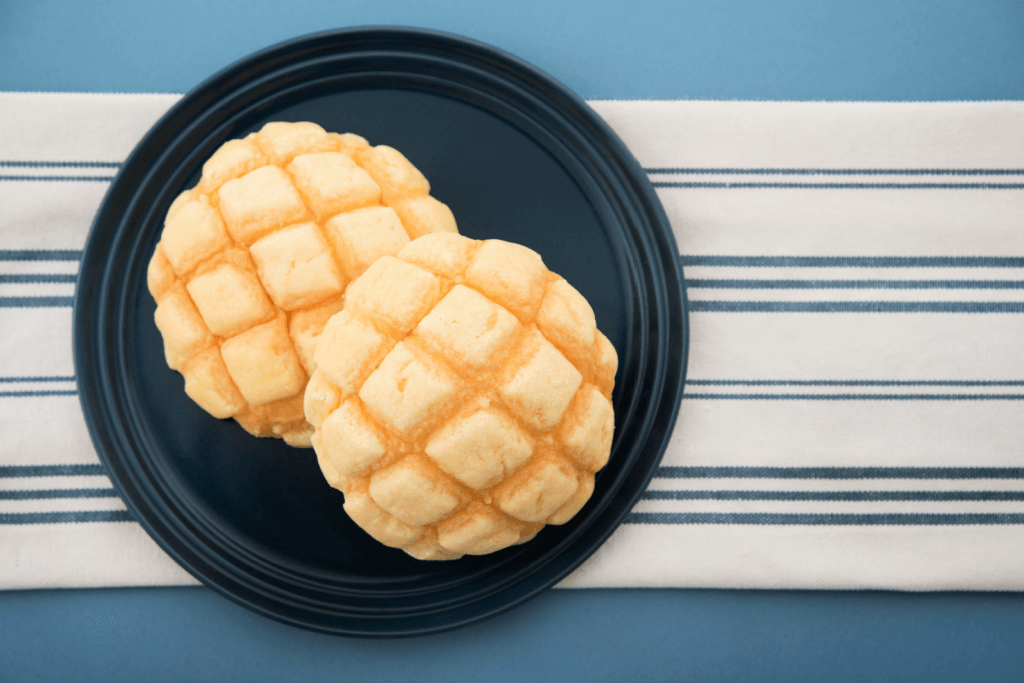Not everyone has a sweet tooth. However, if you’re here to learn about one of the top treats in Japanese sweets, you’re likely interested. So sit back and behold why the melonpan holds a special place in the heart of many Japanese food lovers.
Table of Contents
ToggleWhat is melonpan?
Melonpan consists of a thin cookie dough covering that generously sprinkles sugar on sweet bread. The dough covering often features a signature cross-hatching pattern, although other patterns are also available for sale. Plus, melonpan is available in local bakeries, konbini, specialty shops, and street vendors throughout Japan. Therefore, if you crave this pastry, you won’t have to search far.
The name “melonpan” combines the Japanese word メロン, which means “melon,” with パン, meaning “bread.” Additionally, it reflects the Japanese practice of creating words from different origins, resulting in a unique Japanese term.

The treat fits into sweet Japanese bread called kashipan, which includes well-known treats such as anpan, jamupan, and chocopan. This category typically refers to room-temperature bread with a specific filling that shares its name. Melonpan, on the other hand, initially had no filling. In addition, even though its name references the melon’s round shape, it has a simple sweet taste by default.
How did melonpan spread?
People started making melonpan in various flavors such as melon, chocolate chip, matcha, and strawberry. They became prevalent by filling the melonpan with cream, custard, jam, sweet bean, and even ice cream. Vying for pastry supremacy, pastry producers offer an ever-increasing flavor and topping range, arguably the best part about the treat. Exploring Tokyo and wider Japan for flavors and combinations, you haven’t tried yet is one of the noblest pastimes!

The shape of the melonpan is also the subject of mild debate, but it ultimately reveals regional differences. In most parts of Japan, the round bun with cross-hatching on the cookie covering is considered a melonpan. However, in Kobe and Hiroshima, a melonpan is an oval or seed-shaped bun with parallel ridges, while a round-shaped bun with a sunburst pattern on the top layer of dough is referred to as a Sunrise (サンライズ).
Where did the pastry come from?
As with many culinary inventions, the origins of the melonpan are mainly unknown. Whatever the truth, we owe many thanks to the genius that has brought our taste buds the blessing of this dish. However, the popular account suggests that a worldly Japanese noble named Kihachirō Ōkura “discovered” an Armenian baker named Hovhannes (Ivan) Ghevenian Sagoyan in a hotel in China in 1917. Subsequently, Ōkura brought Sagoyan to Japan, where he would go on to “invent” the melon-shaped pastry.
Melonpan is very similar to the pineapple bun from Hong Kong and other similar buns from Taiwan and China, which may hint at its true origins or merely part of Japan’s 20th-century habit of exporting its culture to its neighbors. The pineapple bun has a denser, moister, and flakier texture with a buttery center compared to the Japanese melonpan, which has a slightly drier, fluffier texture with a crunchier outer layer.

How do I make melonpan?
Preparing the melonpan recipe is not exactly straightforward, especially when incorporating a sweet filling, but once the masterpiece is complete, there will be no further complaints. The basic way is to make a bread dough with flour, yeast, sugar, milk, butter, and eggs.
After letting it rise and kneading out the gases, make small dough balls wrapped in a thin layer of sugar cookie dough. Prepare the cookie dough on the side using cake flour, butter, sugar, eggs, and baking powder. Shape the dough into a ball and wrap it in a cookie. Cross-hatch the cookie layer and bake it to perfection.
A melonpan’s flavor largely depends on the type you are going for. Starting with the granddaddy of them all, the original flavor is a sweet fluffy bun of delight. The inner portion offers a soft and satisfying bite, while the outer cookie layer has a shiny, sugary glaze, providing a perfect crunch. These elements combine to create a chomping experience that inspires a child-like nostalgia.
As the bun dissolves in your mouth, the full extent of the sugar and butter becomes clear, and at that moment, the world seems to be set right. Naturally, you can go for all fillings, flavors, and toppings that will cleverly tweak this experience slightly, leaving you craving more.
If you started this article unfamiliar with melonpan, I hope I have brought you up to speed. The next thing you can do is go out and get one! Tokyo and other parts of Japan boast killer specialty shops, like Kagetsudo in Asakusa and the Melonpan-Ice chain throughout the main islands. If you’re feeling adventurous, perhaps even make some at home yourself!









